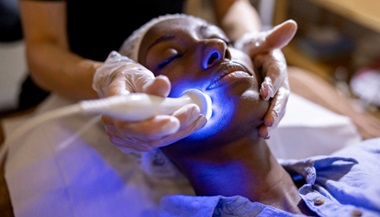Inflamed/Infected Sweat Glands (Hidradenitis)
Hidradenitis occurs when the hair follicles and nearby apocrine glands (sweat glands) on the underarms, groin, buttocks and under the breasts become infected and inflamed.
What is hidradenitis?
While what actually causes hidradenitis is poorly understood, the process itself is clearly documented.
Hair follicles and glands which produce sweat on the underarms, groin, buttocks and under the breasts for some women, become clogged, unable to slough out dead skin cells. When this happens, the clogged follicle or gland provides a breeding ground for bacteria. There is no way for the infectious material to escape the clogged hair follicle, so a cyst forms, similar to a large, thick pimple.
When the cysts do burst, the inflammatory material spreads to nearby hair follicles and the process begins again. After a while, connections between the cysts develop, called sinus tracts, which connect the follicles together and makes it even easier for the inflammation and secondary bacterial infections to travel back and forth.
This painful condition can cause social isolation and depression. Many patients feel their quality of life is severely affected.
Who gets hidradenitis?
Hidradenitis affects 2-3% of the US population, but the number may be higher because so few people discuss this painful condition with their doctors. Other factors associated with developing hidradenitis, include being:
-
Female: Hidradenitis affects four times more women than men
-
African American
-
Obese
-
A smoker
Hormonal influences are also thought to influence who will develop the condition, but there is no clear evidence that this is the case.
Hidradenitis Suppurativa Q&A
Hidradenitis Symptoms
The symptoms of hidradenitis are the cysts themselves. The severity of the symptoms is equal to how severe the condition is in each person, but in general, people can experience
-
Severe itching
-
Pain
-
Scarring
-
Sinus tracts: those “canals” that join each follicle
-
Recurring infections
-
Depression and withdrawal from social activities
Hidradenitis Diagnosis
Doctors diagnose hidradenitis by examining the cysts and follicles, and listening carefully to a patient’s history. There is no specific blood or laboratory test.
Hidradenitis Treatment
Our doctors are firmly committed to helping patients manage this long-term chronic condition, not only to treat the cysts and prevent further infections, but also to improve quality of life.
While there is no cure, there are many treatments for hidradenitis, including oral medications, controlled opening of the cysts and laser hair removal.







